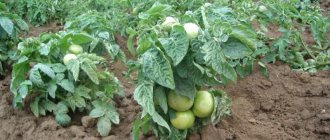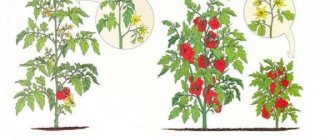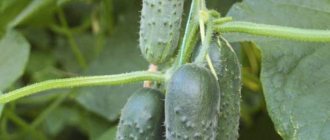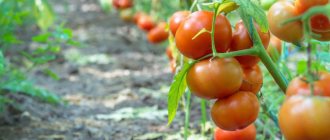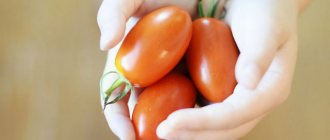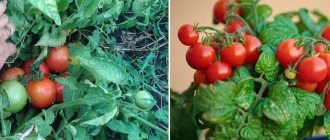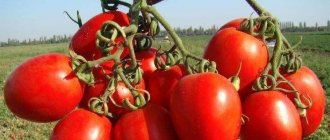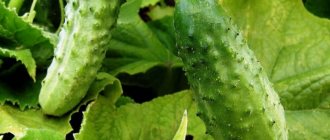How long will they sleep?
Mid-early tomatoes include vegetables that ripen in 100-120 days.
This classification is very conditional, because depending on the conditions, the indicator may change, so the difference between early and mid-early varieties is sometimes simply erased.
In a garden, you can’t calculate everything down to the day, because much is influenced by the weather, the quality of the seeds, planting depth, and the correct selection of varieties.
List of super early tomato varieties
You will find more detailed information on each variety in our articles.
For your convenience, we have compiled a table of mid-early tomato varieties in alphabetical order :
| Openwork | Babushkino | Budenovka | Giant red |
| Danko | Dina | Mystery of nature | Golden King |
| Emerald Apple | Cardinal | Bells of Russia | King Penguin |
| King of the Giants | King London | Leo Tolstoy F1 | Major F1 |
| Bear Paw | A lazy man's dream | New from Transnistria | New Koenigsberg |
| Orange giant | Pink Bush F1 | Bullet | Rosaliza F1 |
| Pink King F1 | Russian soul | Sugar giant | Siberian miracle |
| One hundred poods | Sultan F1 | Supermodel | Timofey F1 |
| Titan pink | Titanic F1 | Torbay F1 | Tretyakovsky |
| Flamingo | Hospitable | Khlynovsky F1 | F1 Champion |
| Black Crimea | Cio Cio San | Em Champion |
What type are they usually classified as?
There are 2 main varieties of tomatoes: indeterminate and determinate.
- The first type of vegetable is also called tall , since it practically does not stop growing, bud after bud gradually appears. The plant develops like a vine. It can be quite high (up to 2 meters in height).
- The second type of vegetables is also called low-growing , because the formation of buds and stepsons occurs mainly on the lower part of the plant. A bush is formed, not a vine.
Sometimes a third type is also distinguished: superdeterminant , but it does not occur often. Such plants are usually not tall at all, the bushes are compact and unpretentious in care.
Mid-early tomato varieties are almost always determinate , but those species that are grown in greenhouses can also be indeterminate.
The compact growth form allows the plant to be as hardy as possible. Greenhouse conditions do not require tomatoes of this quality.
Varieties of medium-sized tomatoes in a greenhouse (video)
Branch garters must be carried out. Remember, the larger the bush, the more it needs supports. This especially applies to branches with large fruits. Phosphorus- and potassium-containing fertilizers are well suited for feeding.
- Author: admin
Rate this article:
- 5
- 4
- 3
- 2
- 1
(1 vote, average: 5 out of 5)
Share with your friends!
Where can it be grown?
Another very important parameter for growing tomatoes is the location where they will grow. So, they can be grown in greenhouses or in open ground.
Important: The choice of planting site depends on the type and ripening period, as well as climatic conditions.
It is clear that if you live in a cold climate, then it is unlikely that you will be able to grow tomatoes in your dacha. Tomatoes are much better suited for temperate climates.
If you want to grow vegetables in the country, that is, in open ground, then super-early, early and mid-early varieties are perfect for this purpose.
Typically, determinate tomatoes are chosen, which are less susceptible to disease and the negative effects of climate.
For cultivation in greenhouses, mid-late and late varieties are usually used.
The indeterminate type predominates in greenhouse conditions. Mid-early tomatoes are also grown in greenhouses, but not as often as in open ground.
When to prepare seedlings?
Anyone who grows vegetables knows how important it is to properly prepare seedlings.
Mid-early varieties are sown between March 10 and April 7.
This is the optimal period that allows the vegetable to sprout properly and be saturated with nutrients. This is the time to prepare the seedlings.
Productive tall and medium-growing hybrid varieties
Intuition F1 mid-season determinant
Mid-season (95-115 days) hybrid of indeterminate type. The plant is medium branched, reaches a height of 2 meters. The first brush is tied over 8-9 sheets, the next after 3 sheets. Forms compact, crease-free hands. The fruits are round, smooth, glossy red, weigh about 100 g, and contain a lot of sugars. The taste of the fruit is good.
Advantages: excellent harvest, high marketability of fruits. It does not crack, is stored for a long time, and can be collected with brushes. The fruits of the hybrid are good in salads and homemade preparations.
Agrotechnical features: hybrid Intuition F1 is used in extended and summer-autumn greenhouse cultivation. Resistant to a number of diseases (fusarium, cladosporiosis, tobacco mosaic virus). The plant is climbing, formed into one stem. Productivity: 7.8 kg/m2.
Kostroma F1
Determinate tomato has a medium early ripening period, the first fruits are harvested after 106 days from germination. Medium-branched bush up to 2 m tall, internodes of medium length. The leaf is matte light green. The first brush is placed above 6-7 sheets, the rest after 1-2. The fruits are rounded-flattened, slightly ribbed, glossy, bright red in color, weighing up to 85-145 g, in clusters of 6-9 pieces.
Advantages: resistance to viruses, temperature and humidity fluctuations. The harvest ripens together. The commercial quality of the fruit is good. The taste is dessert, the purpose is universal.
Agrotechnical features: grown in greenhouses and film greenhouses. Formed on a vertical trellis. Brushes need to be tied to avoid breakage. After 8-10 brushes, it is recommended to pinch the central shoot.
Read about pinching cucumbers at the link.
Productivity: up to 5 kilograms per bush. Tomato Kostroma F1 is highly appreciated by farmers.
Harvest Rosemary F1
Hybrid, ripening in medium terms (115 days). Powerful indeterminate bush up to 1.5 m in height with dark green large leaves. The first inflorescence is laid over 10-11 leaves, followed by 3 leaves. Large (260-300 g), pink, slightly ribbed fruits. The pulp has a dessert taste and a delicate salad consistency. The fruits are used for fresh consumption, juices, and baby food.
Advantages: excellent taste, high yield.
Agrotechnical features: grown under film covers.
Productivity: 10-12 kg per sq.m.
Super productive Chio-chio-san
Indeterminate medium-sized hybrid with an average ripening period of 110-120 days. The leaves are dark green, medium. The first brush is above the 9th sheet, the next after 3 sheets. Forms many branched clusters (up to 50 fruits). The tomatoes are plum-shaped, glossy, pink, weigh 40 g. The taste is excellent, dessert. Good for salads.
Advantages: High yield, wonderful taste. Not affected by tobacco mosaic.
Agrotechnical features: grown under film covers.
The yield is 7.8 kg/sq.m - up to 4 kg per bush.
Features of such tomatoes
A feature of many mid-early tomatoes is their productivity ; usually these types of vegetables bear a large number of fruits.
Almost all varieties for greenhouses are characterized by excellent resistance , take root easily and do not require special care, as they are not susceptible to disease.
Outdoor varieties, in general, also have good resistance to diseases and other problems, but it is still advisable to consult with other gardeners regarding special procedures.
Mid-early tomatoes can vary in size. Thus, the fruits of the “King London” variety are truly gigantic, “Pink Bush” are medium-sized, and “Chio Cio San” are small.
Mid-early varieties also differ in color and shape, so every gardener will find those types of tomatoes that are perfect for him.
The most popular in open ground and greenhouses
The tomato varieties Semko-Sinbad, De Barao, and the hybrid Ivanhoe F1 have received well-deserved distribution in amateur and farm farms. In a greenhouse, these varieties can produce a yield of more than 20 kg per bush.
De Barao late ripening
The most common tomato variety for both greenhouses and open ground is often called golden De Barao. With good care in a greenhouse it yields up to 30 kg per plant, in open ground - 10 kg.
Late-ripening (120 days) indeterminate variety with a height of 2 m or more. Inflorescences are formed from 9-11 leaves. The fruits are medium-sized, ovoid, weighing 60 g. The taste is pleasant. De Barao fruits are good both fresh and for canning whole fruits.
Agrotechnical features: sensitive to soil looseness, fertilizing and microclimate.
Several variations of this variety have been bred: De Barao black, pink, yellow. They are all tasty, beautiful and productive.
The recorded harvest record is 70 kg per bush.
Very tasty early ripening Semko-Sinbad F1
Quite old, but still popular early ripening hybrid. Valued for its early maturity - 85-93 days from emergence. Determinate plant. The inflorescence contains 8 round, smooth fruits weighing 85-90 g. The first cluster appears above the 6-7 leaf, the rest after 1-2 leaves. The taste is good and excellent. Produces yield well and is disease resistant. The Semko-Sinbad F1 tomato can be planted both in a film greenhouse and in open ground. Productivity – 10 kg per 1 sq. m.
Ivanhoe F1
Mid-season, indeterminate. The bush is large, with powerful stems and roots. The fruits are flat-round, ribbed, dense, red. Fruit weight is 170-180 g, tomatoes do not decrease from the base of the bush to the top. The taste is good, the fruits are transportable and do not crack. Universal use. Ivanhoe F1 is very disease resistant and can be grown without the use of chemicals.
Alhambra F1
Indeterminate bush, short internodes. The inflorescence according to the description is formed above the 9th leaf, the next ones - after 3 leaves. The fruits are round, slightly ribbed, red, weighing up to 170 g. The clusters do not break. The taste is excellent for hybrid fruits.
Resistant to a number of diseases (fusarium, cladosporiosis and tobacco mosaic virus).
